|

|
|
| |
|
China Oil Painting Direct
|
|
100% hand painted, 100%
cotton canvas,
100% money back if not satisfaction.
|
|
|
|
ART WORKS
INDEX
A B C D E F G H I J K L M N O P Q R S T U V W X Y Z
|
|
ARTISTS
INDEX
A B C D E F G H I J K L M N O P Q R S T U V W X Y Z
|
|
|
|
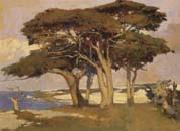 |
Arthur Mathews 
|
|
an American Tonalist painter who was one of the founders of the American Arts and Crafts movement
1860-1945
|
|
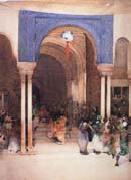 |
Arthur Melville 
|
|
British Painter, 1858-1904, Scottish painter. He was trained in Edinburgh under James Campbell Noble (1846-1913) and at the Royal Scottish Academy Schools. His early works are peasant subjects in a subdued tonal style. While at the Acad?mie Julian in Paris and at Grez-sur-Loing (1878-81) he developed a colouristic watercolour style with strong chiaroscuro. This was consolidated during his journey in 1881 to Egypt and Constantinople, and on trips between 1890 and 1893 to Spain (with Frank Brangwyn) and North Africa. Contrasts of strong sunlight and coloured shadows were created in his 'blottesque' technique of colour droplets on paper saturated with Chinese white: sponge and brushwork were used to clarify form, as in Little Bullfight: 'Bravo Toro' (c. 1888-9; London, V&A). He was associated with the Glasgow Boys and influenced their development of colour and design. His closest contact with them came during outdoor sketching trips in Scotland between 1882 and 1889, and in Paris in 1886 and 1889. In 1886 he became an Associate of the Royal Scottish Academy and developed a strongly decorative oil style, seen in Audrey and her Goats (1884-9; London, Tate).
|
|
 |
Arthur Melville,ARSA,RSW,RWS 
|
|
1855-1904
|
|
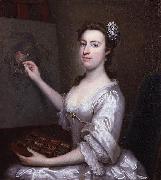 |
Arthur Pond 
|
|
Arthur Pond (1705?-1758) was an English painter and engraver.
Born about 1705, was educated in London, and stayed for a time in Rome studying art, in company with the sculptor Roubiliac. He became a successful portrait-painter.
He was elected a Fellow of the Royal Society in 1752, and died in Great Queen Street, Lincoln's Inn Fields, 9 September 1758.
His numerous original portraits include Alexander Pope, William, Duke of Cumberland, and Peg Woffington. Pond was also a prolific etcher, and used various mixed processes of engraving by means of which he imitated or reproduced the works of masters such as Rembrandt, Raphael, Salvator Rosa, Parmigiano, Caravaggio, and the Poussins.
In 1734-5 he published a series of his plates under the title Imitations of the Italian Masters. He also collaborated with George Knapton in the publication of the Heads of Illustrious Persons, after Jacobus Houbraken and George Vertue, with lives by Thomas Birch (London, 1743-52); and engraved sixty-eight plates for a collection of ninety-five reproductions from drawings by famous masters, in which Knapton was again his colleague. Another of his productions was a series of twenty-five caricatures after Pier Leone Ghezzi, republished in 1823 and 1832 as Eccentric Characters.
|
|
 |
Arthur Quartley 
|
|
(May 24, 1839 - May 19, 1886), was an American painter known for his marine seascapes.
Quartley was born in Paris and lived there to the age of twelve, when his family moved to Baltimore, Maryland. He studied drawing with his father C.G. Quartley, who was an English engraver. His father was reputed to have demanded two drawings per week from the young lad. At age 17, Arthur was apprenticed to a sign painter in Baltimore.
In 1862 Quartley and his family founded a design firm in Baltimore. The firm Emmart & Quartley was regarded as the best decorating company in the city (Dictionary of American Biography); however, young Quartley began painting marine seascapes of Chesapeake Bay, and progressively spent more and more time in that pursuit. He held a successful show of marine paintings at the studio of Norval H. Busey in Baltimore. Scholar Elizabeth Johns remarked that Quartley's work reveals familiarity with the Dutch Masters marine tradition of composition in treatment of light and color.
To pursue his painting more seriously, Quartley moved to New York City in 1875. New York at that time had become a premier center for notable painters. From there he painted seascapes of Long Island bays, New York Harbor, the New Hampshire Isle of Shoals, and Naragansett Bay in Rhode Island.
The Hudson River School was waning at this point, so that other groups were forming, among them the Tilers, of whom Quartley was a founding member. The Tilers was a group of artists and writers, that included such luminaries as Winslow Homer, William Merritt Chase, and Augustus Saint Gaudens. They met frequently to exchange ideas and decorate ceramic tiles in promotion of their works. They also took excursions for painting, such as the 1878 pilgrimage to Eastern Long Island by Quartley and ten others. On that trip Quartley painted Seascape and also a blue painted tile of an introspective girl at the beach. The journalist and philanthropist John W. McCoy promoted the careers of Quartley and of his friend, the sculptor William H. Rinehart.
|
|
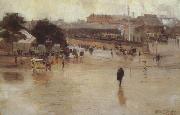 |
Arthur streeton 
|
|
1867 - 1943
Australian painter. He moved to Melbourne with his family when he was seven. In 1882 he enrolled as a student of drawing at the evening classes of the National Gallery School of Design and briefly in the School of Painting, but he had no sustained formal instruction in painting. At the same time he began making watercolour sketches of Melbourne, and by 1886 his skill led to an apprenticeship as a lithographer to George Troedel and Co. of Collins Street. The most important early influence on Streeton was Tom Roberts, who had returned to Melbourne from Europe in 1885. With Frederick McCubbin, Streeton and Roberts painted en plein air at a temporary camp at Box Hill, forming what became known as the HEIDELBERG SCHOOL. A little later Streeton established the first permanent artists' camp at Eaglemont, north-west of Melbourne, overlooking the Yarra Valley, where he painted some of his most memorable works. 'Still glides the stream and shall forever glide'
|
|
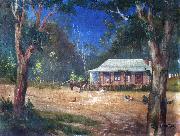 |
Arthur Tozart 
|
|
(1800 -1900 ) - Painter
|
|
 |
Arthur William Devis 
|
|
(10 August 1762 - 11 February 1822) was an English painter of history paintings and portraits. He was appointed draughtsman in a voyage projected by the East India Company in 1783, under Captain Henry Wilson, in which he was wrecked on the Pelew Islands before proceeding to Canton and thence to Bengal. He painted portraits and historical subjects, sixty-five of which he exhibited (1779-1821) at the Royal Academy.
|
|
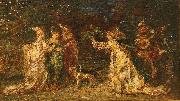 |
Artist Adolphe Joseph Thomas Monticelli 
|
|
(October 14, 1824 - June 29, 1886) was a French painter of the generation preceding the Impressionists.
Monticelli was born in Marseille in humble circumstances. He attended the École Municipale de Dessin in Marseille from 1842 to 1846, and continued his artistic training in Paris, where he studied under Paul Delaroche at the École des Beaux-Arts. In Paris he made copies after the Old Masters in the Louvre, and admired the oil sketches of Eugene Delacroix. In 1855 he met Narcisse Diaz, a member of the Barbizon school, and the two often painted together in the Fontainebleau Forest. Monticelli frequently adopted Diaz's practice of introducing nudes or elegantly costumed figures into his landscapes.
He developed a highly individual Romantic style of painting, in which richly colored, dappled, textured and glazed surfaces produce a scintillating effect. He painted courtly subjects inspired by Antoine Watteau; he also painted still lives, portraits, and Orientalist subjects that owe much to the example of Delacroix.
After 1870, Monticelli returned to Marseille, where he would live in poverty despite a prolific output, selling his paintings for small sums. An unworldly man, he dedicated himself singlemindedly to his art.
The young Paul Cezanne had befriended Monticelli in the 1860s, and the influence of the older painter's work can be seen in Cezanne's work of that decade. Between 1878 and 1884 the two artists often painted landscapes together, once spending a month roaming the Aix countryside. Although Monticelli experimented briefly around 1870 with a treatment of light reflecting the discoveries of the Impressionists, he found the objectivity of this approach uncongenial.
Confronted with criticism of his style of painting Monticelli himself remarked, "I paint for thirty years from now". The work of this instinctive painter reached its greatest spontaneity in the decade before his death in 1886.
|
|
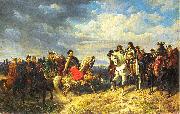 |
Artur Grottger 
|
|
(1837 - 1867) was a Polish painter and graphic designer, one of the most prominent artists of the early 1800s despite his brief life.
He was born in Eastern Galicia to an amateur artist of German background, Jan Jozef Grottger, and a Polish mother. Grottger studied painting under the apprenticeships of Jan Kanty Maszkowski and Juliusz Kossak in Lwew. Grottger received an imperial scholarship to attend the Krakow School of Fine Arts, where he studied under Władysław Łuszczkiewicz and Wojciech Kornel Stattler. Around this time he met one of his biggest future art patrons and benefactors, Aleksander Pappenheim.
Grottger painted mostly epic battle scenes. He moved to Vienna in 1854, where he produced some of his most famous paintings. In 1865, Grottger returned to Poland and stayed in Krakew and Lwew, but left this time for good in 1866.
|
|
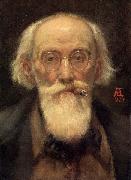 |
Artur Loureiro 
|
|
painted Auto-Retrato in 1925
|
|
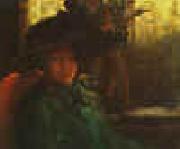 |
Artur Timoteo da Costa 
|
|
Brazilian
1882-1923
Artur Timoteo da Costa Gallery
|
|
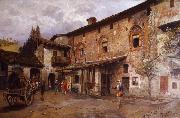 |
Arturo Ferrari 
|
|
(Milan, 1861 - 1932) was an Italian painter.
Initiated into artistic studies by his father Cesare, an associate of Luigi Scrosati, and the painter Mose Bianchi from Lodi, Arturo Ferrari completed his training at the Brera Academy under the guidance of Giuseppe Bertini from 1877 to 1884 while working in the studio of Gerolamo Induno at the same time. He made his debut at the Esposizione di Belle Arti di Brera in 1879 with a view of the interior of Milan Cathedral, thus inaugurating the repertoire of Milanese perspective views that was to be a constant feature of his vast production of oil paintings and watercolours. He soon became the guiding spirit of a poetic and sentimental evocation of "Old Milan" during the phase of transition to the 20th century, when the face of the city changed radically through wholesale rebuilding. A regular participant in all the major exhibitions until 1932, the year of his death, he was the recipient of numerous marks of official recognition and enjoyed considerable success with the public as well as the esteem of conservative critics.
|
|
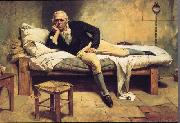 |
Arturo Michelena 
|
|
16 June 1863 - 29 July 1898) was a Venezuelan painter born in Valencia, Carabobo State. He began to paint at a young age under his father's tutelage. Traveled to Paris where he studied in the famous Academie Julian. He was the first Venezuelan artist to succeed overseas and, with Cristebal Rojas (1857-1890) and Marten Tovar y Tovar (1827-1902), one of the most important Venezuelan painters of the 19th century.
His first great success occurred in Paris at Le Salon des Artistes Français in 1887. Encouraged by his teacher Jean-Paul Laurens (1838-1921), Michelena presented a canvas titled L'Enfant Malade (The sick boy) which was awarded the Gold Medal, second class, the highest honor a foreign artist could receive at the salon. The painting was quickly considered a masterpiece and was acquired by the Astors in New York in the late 19th century. Later the painting traveled to South Florida when it was acquired by Owens Burns, a business partner of John Ringling, the circus magnate. After Burns' death the painting was stored in the Ringling Museum's vaults where it remained away from public view for more than 60 years. In 2004 Sotheby's rescued the canvas and arranged for it to be included in an auction of Latin American art.
|
|
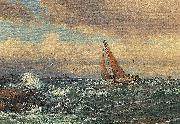 |
Arvid Ahlberg 
|
|
painted Segelbatar, Vastkusten in 1907
|
|
 |
Arvid Johanson 
|
|
(born 3 February 1929) was a Norwegian newspaper editor and politician for the Labour Party. He served five full terms in the Parliament of Norway, was Norway's second Minister of Petroleum and Energy, and outside of politics he spent most of his career in the newspaper Halden Arbeiderblad.
He was born in Halden as a son of Arvid Martin Johanson (1896 - 1981) and housewife Karla Niemi (1899 - 1932). He started his career as a journalist in Halden Arbeiderblad in 1947, and remained there for a year. In 1949 he worked in Sarpsborg Arbeiderblad. He returned to Halden Arbeiderblad, and remained there for the rest of his career. He underwent studies at the Norwegian Journalist Academy from 1942 to 1953 and at Fircroft College from 1954 to 1955. He was a board member of the county chapter of the Norwegian Press Association from 1954 to 1955.
|
|
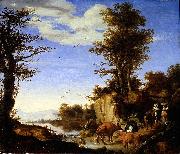 |
Ary de Vois 
|
|
was a Dutch Golden Age painter.
Ary de Vois was the son of Alewijn de Vois from Utrecht, who was organist in the Pieterskerk, Leiden, in 1635. Ary became a pupil in Utrecht of Nikolaus Knepfer, who also taught Jan Steen. Ary then returned to Leiden to study with Abraham van den Tempel, who lived there between 1648 and 1660. De Vois joined the Leiden Guild of St Luke on 16 October 1653, paying dues until 1677. He was dean in 1662-64, headman in 1664-65 and dean again from 1667-68. He married Maria van der Vecht, on 5 February 1656.
According to Houbraken his marriage caused a lull in his production, especially when he moved to Warmond where he took up fishing as a hobby. He had to move back to Leiden in order to keep his production levels high
|
|
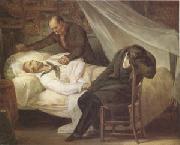 |
Ary Scheffer 
|
|
Dordrecht 1795-Argenteuil 1858
Dutch painter, sculptor and lithographer, active in France. He became a French citizen in 1850. He received his earliest training in the studio of his parents, Johann-Bernhard Scheffer (1764-1809) and Cornelia Scheffer (1769-1839), who were both artists, as was his brother Henri Scheffer (1798-1862). He then attended the Amsterdam Teeken-Academie (1806-9). At the first Exhibition of Living Masters in Amsterdam in 1808 he showed Hannibal Swearing to Avenge the Death of his Brother Hasdrubal
|
|
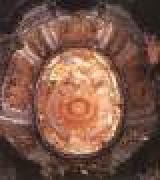 |
ASAM, Cosmas Damian 
|
|
German Baroque Era Sculptor, 1686-1739
Bavarian architects and decorators. After studying in Rome (1711 ?C 13), Cosmas Damian became a prolific fresco painter, and his brother, Egid Quirin, became a sculptor and stuccoist. They developed the effects of dramatic lighting and illusionism originated by Gian Lorenzo Bernini and Andrea Pozzo. Working as a team, they produced magnificent illusionistic decoration in ecclesiastical buildings, combining dramatic lighting and colour. Their works are notable for their profound and dramatic intensity of religious feeling. The brothers became the principal late Baroque exponents of illusionist decoration in religious architecture. Their most notable collaboration is the church of St. John Nepomuk in Munich (1733 ?C 46) ?? known as the Asamkirche in honour of the brothers.
|
|
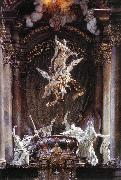 |
ASAM, Egid Quirin 
|
|
German Baroque Era Sculptor, 1692-1750
Sculptor, stuccoist, painter and architect, son of Hans Georg Asam. After working with his father, he was apprenticed to Anton Faistenberger in Munich to learn sculpture. He presumably accompanied his brother Cosmas Damian Asam to Rome (1711-13), where he studied works by Bernini. In 1724 he became a valet and court stuccoist to the Prince-Bishop of Freising and in 1730 a valet to the Elector of Bavaria.
|
|
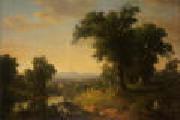 |
Asher Brown Durand 
|
|
1796-1886
Asher Brown Durand Galleries
His interest shifted from engraving to oil painting around 1830 with the encouragement of his patron, Luman Reed. In 1837, he accompanied his friend Thomas Cole on a sketching expedition to Schroon Lake in the Adirondacks and soon after he began to concentrate on landscape painting. He spent summers sketching in the Catskills, Adirondacks, and the White Mountains of New Hampshire, making hundreds of drawings and oil sketches that were later incorporated into finished academy pieces which helped to define the Hudson River School.
Durand is particularly remembered for his detailed portrayals of trees, rocks, and foliage. He was an advocate for drawing directly from nature with as much realism as possible. Durand wrote, "Let [the artist] scrupulously accept whatever [nature] presents him until he shall, in a degree, have become intimate with her infinity...never let him profane her sacredness by a willful departure from truth."
Like other Hudson River School artists, Durand also believed that nature was an ineffable manifestation of God. He expressed this sentiment and his general views on art in his "Letters on Landscape Painting" in The Crayon, a mid-19th century New York art periodical. Wrote Durand, "[T]he true province of Landscape Art is the representation of the work of God in the visible creation..."
Durand is noted for his 1849 painting Kindred Spirits which shows fellow Hudson River School artist Thomas Cole and poet William Cullen Bryant in a Catskills landscape. This was painted as a tribute to Cole upon his death in 1848. The painting, donated by Bryant's daughter Julia to the New York Public Library in 1904, was sold by the library through Sotheby's at an auction in May 2005 to Alice Walton for a purported $35 million. The sale was conducted as a sealed, first bid auction, so the actual sales price is not known. At $35 million, however, it would be a record price paid for an American painting at the time.
|
|
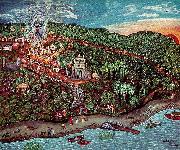 |
asillia guillen 
|
|
|
|
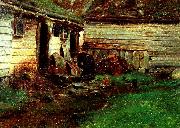 |
askevold 
|
|
Anders Monsen Askevold was born in Askvoll, Norway in 1834. His early training started at the age of thirteen in Bergen under Hans Leganger Reuch. He trained in Dusseldorf under Professor Hans Gude from 1855 until 1859. and he is known as a member of the Dusseldorf school with others like Adelsteen Normann.
From 1861 to 1866 he was in Paris. After this he moved back to Dusseldorf where he would spend his winters in Germany and his summers in Norway.
Askevold did some commissions for churches in Norway. He died in 1900 in Dusseldorf.
|
|
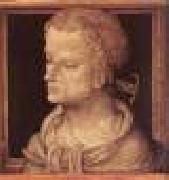 |
ASPERTINI, Amico 
|
|
Italian Painter, ca.1474-1552
He was born in Bologna to a family of painters (Guido Aspertini and Giovanni Antonio Aspertini, his father), and studied under masters such as Lorenzo Costa and Francesco Francia. He is briefly documented in Rome between 1500-1503, returning to Bologna and painting in a style influenced by Pinturicchio. In Bologna in 1504, he joined Francia and Costa in painting frescoes for the newly restored Oratory of Santa Cecilia in San Giacomo Maggiore, a work commissioned by Giovanni II Bentivoglio.
In 1507-09, he painted a fresco cycle in San Frediano in Lucca. Asperini painted in 1508-1509 the splendid frescoes in the Chapel of the Cross in the Basilica di San Frediano in Lucca. Aspertini was also one of two artists chosen to decorate a triumphal arch for the entry into Bologna of Pope Clement VII and Emperor Charles V in 1529.
He died in Bologna.
Giorgio Vasari describes Aspertini as having an eccentric personality, who, half-insane, worked so rapidly with both hands that chiaroscuro was split, chiaro in one hand, scuro in the other. He quotes Aspertini as complaining that all other Bolognese colleagues were copying Raphael. Aspertini also painted façade decorations (all lost), and altarpieces, many of which are often eccentric and charged in expression. For example, his Bolognese Pieta appears to occur in an other-worldy electric sky.
|
|
 |
ASSELYN, Jan 
|
|
Dutch Baroque Era Painter, ca.1615-1652
|
|
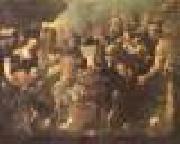 |
ASSERETO, Gioachino 
|
|
Italian painter, Genoese school (b. 1600, Genova, d. 1649, Genova)
|
|
 |
AST, Balthasar van der 
|
|
Dutch Baroque Era Painter, ca.1593-1656
1657). Dutch painter. He was the brother-in-law of Ambrosius Bosschaert (i), whose household he entered in 1609, after the death of his father. He remained as Bosschaert's pupil, until he was 21. In 1615 van der Ast moved with the Bosschaert family to Bergen-op-Zoom. However, a year later the Bosschaerts were living in Utrecht, but van der Ast is not recorded there until 1619, when he was entered as a master in the Guild of St Luke. He remained in Utrecht until 1632, then lived in Delft, where he enrolled in the painters' guild on 22 June 1632. On 26 February 1633 he married Margrieta Jans van Bueren in Delft, where he spent the rest of his career; the marriage produced two children.
|
|
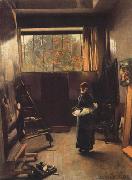 |
Asta Norregaard 
|
|
impression artist
1853-1933
|
|
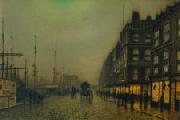 |
Atkinson Grimshaw 
|
|
British
1836-1893
Atkinson Grimshaw Gallery
Grimshaw's primary influence was the Pre-Raphaelites. True to the Pre-Raphaelite style, he put forth landscapes of accurate color and lighting, and vivid detail. He often painted landscapes that typified seasons or a type of weather; city and suburban street scenes and moonlit views of the docks in London, Leeds, Liverpool, and Glasgow also figured largely in his art. By applying his skill in lighting effects, and unusually careful attention to detail, he was often capable of intricately describing a scene, while strongly conveying its mood. His "paintings of dampened gas-lit streets and misty waterfronts conveyed an eerie warmth as well as alienation in the urban scene."
Dulce Domum (1855), on whose reverse Grimshaw wrote, "mostly painted under great difficulties," captures the music portrayed in the piano player, entices the eye to meander through the richly decorated room, and to consider the still and silent young lady who is meanwhile listening. Grimshaw painted more interior scenes, especially in the 1870s, when he worked until the influence of James Tissot and the Aesthetic Movement.
On Hampstead Hill is considered one of Grimshaw's finest, exemplifying his skill with a variety of light sources, in capturing the mood of the passing of twilight into the onset of night. In his later career this use of twilight, and urban scenes under yellow light were highly popular, especially with his middle-class patrons.
His later work included imagined scenes from the Greek and Roman empires, and he also painted literary subjects from Longfellow and Tennyson ?? pictures including Elaine and The Lady of Shalott. (Grimshaw named all of his children after characters in Tennyson's poems.)
In the 1880s, Grimshaw maintained a London studio in Chelsea, not far from the comparable facility of James Abbott McNeill Whistler. After visiting Grimshaw, Whistler remarked that "I considered myself the inventor of Nocturnes until I saw Grimmy's moonlit pictures."[9] Unlike Whistler's Impressionistic night scenes, however, Grimshaw worked in a realistic vein: "sharply focused, almost photographic," his pictures innovated in applying the tradition of rural moonlight images to the Victorian city, recording "the rain and mist, the puddles and smoky fog of late Victorian industrial England with great poetry."
Some artists of Grimshaw's period, both famous and obscure, generated rich documentary records; Vincent Van Gogh and James Smetham are good examples. Others, like Edward Pritchett, left nothing. Grimshaw left behind him no letters, journals, or papers; scholars and critics have little material on which to base their understanding of his life and career.
Grimshaw died 13 October 1893, and is buried in Woodhouse cemetery, Leeds. His reputation rested, and his legacy is probably based on, his townscapes. The second half of the twentieth century saw a major revival of interest in Grimshaw's work, with several important exhibits of his canon.
|
|
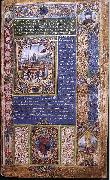 |
ATTAVANTE DEGLI ATTAVANTI 
|
|
Italian miniaturist, Florentine school (b. 1452, Castelfiorentino, d. ca. 1525, Firenze)
|
|
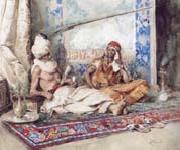 |
Attilio Simonetti 
|
|
Italian, 1843-1925
|
|
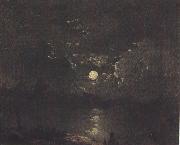 |
Attributed to henry pether 
|
|
fl.1828-1865
|
|
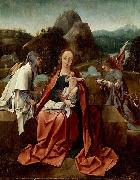 |
Attributed to Jan de Beer 
|
|
painted Madonna and Child with a pilgrim and an angel in c. 1490-1515
|
|
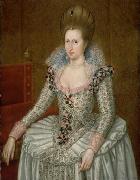 |
Attributed to John de Critz the Elder 
|
|
painted Portrait of Anne of Denmark in c. 1605
|
|
 |
Attributed to Wilkie 
|
|
painted The Christmas Party 1850
|
|
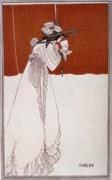 |
Aubrey Beardsley 
|
|
English Art Nouveau/Golden Age Illustrator, 1872-1898
English draughtsman and writer. He was brought up in Brighton, in genteel poverty, by his mother. She gave her children an intensive education in music and books, and by the time he was sent to boarding-school at the age of seven Beardsley was exceptionally literate and something of a musical prodigy. He was also already infected with the tuberculosis that eventually killed him. There is evidence that his talent for drawing was highly developed by the age of ten, and he was subsequently encouraged by his housemaster at Brighton Grammar School, Arthur William King. Beardsley left school at the end of 1888, and in January 1889 became a clerk at the Guardian Life and Fire Insurance Company in the City of London. Attacks of haemorrhaging of the lungs forced him to abandon his job at the end of 1889. On the strength of a short story sold to Tit Bits he tried to pursue a literary career, but when his health improved in the spring of 1890, he returned both to his job and to drawing. Final affirmation of the direction of his art came in July 1891, when he showed his work to Edward Burne-Jones, who told Beardsley: 'I seldom or never advise anyone to take up art as a profession, but in your case I can do nothing else.
|
|
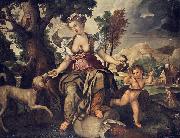 |
Augsburger Schule 
|
|
painted Allegory of Remorselessness in between 1580(1580) and 1600(1600)
|
|
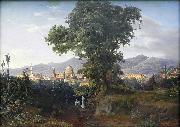 |
August Ahlborn 
|
|
(October 11, 1796 - August 24, 1857) was a German landscape painter.
Ahlborn was born in Hanover, and studied with Karl Wilhelm Wach in Berlin. He went to Italy in 1827, where he converted to Roman Catholicism, and lived in Florence, Ascoli, and Rome. He painted mainly Italian landscapes, but also some Nordic ones, as well as a few portraits and religious works. He died in Rome in 1857.
|
|
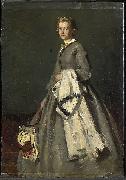 |
August Allebe 
|
|
painted Young woman in 1863
|
|
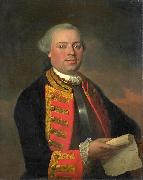 |
August Christian Hauck 
|
|
(1742 -1801 ) - Painter
|
|
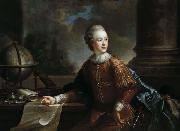 |
August Friedrich Oelenhainz 
|
|
(June 28, 1745 - November 5, 1804) was a German painter.
|
|
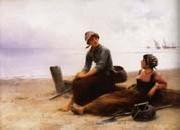 |
August Hagborg 
|
|
1852 - 1925,Swedish painter. He studied at the Konstakademi in Stockholm (1871-5), then went to Paris in the autumn of 1875, where he lived until 1909. He began to exhibit at the Salon as early as 1876 and became one of its most industrious contributors. In 1877 he showed at the Salon his painting Waiting (1877; priv. col., see S. Strembom: Konstnersferbundets historia [History of the Federation of Artists], i (Stockholm, 1945), pl. 35), developed from a study made in Bohuslen on the west coast of Sweden. It shows a young fisherman's wife, her child on her arm, gazing out over the sea and waiting for her husband. This introduced what was to become Hagborg's favourite subject-matter: the fishing community, mostly in Normandy and Brittany. Typical elements of his paintings are young women, depicted in idealized and heroic manner, in theatrical poses, and a realistic background, usually of shallow beaches at ebb tide; in his later works, he painted in more delicate and exquisite, silvery colours.
|
|
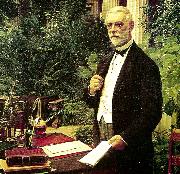 |
august jerdorff 
|
|
|
|
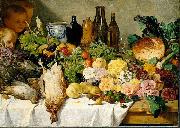 |
August Jernberg 
|
|
(16 September 1826 - 22 June 1896) was a Swedish artist who emigrated to Germany.
In his early years he mainly painted portraits, and historical or biblical pictures. In the 1860s he became a genre and landscape painter. He studied at the Royal Swedish Academy of Arts in Stockholm 1843-1846 and then went to Paris, where he studied under Thomas Couture from 1847 to 1853. In 1854 he settled down in Desseldorf, and remained there until his death, with the exceptions of some shorter trips.
Also his son Olof Jernberg (1855 - 1935) was an artist.
|
|
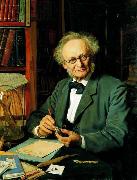 |
August Jerndorff 
|
|
August Andreas Jerndorff (25 January 1846 - 28 July 1906) was a Danish painter who is best known for his portraits.
|
|
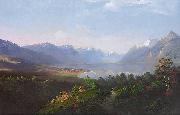 |
August Ludwig Erhard Boll 
|
|
painted Blick auf den Genfer See in 1852
|
|
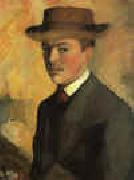 |
August Macke 
|
|
1887-1914
August Macke Locations
August Macke was born in Meschede, Germany. His father, August Friedrich Hermann Macke (1845-1904), was a building contractor and his mother, Maria Florentine, n??e Adolph, (1848-1922), came from a farming family in Germany's Sauerland region. The family lived at Br??sseler Straße until August was 13. He then lived most of his creative life in Bonn, with the exception of a few periods spent at Lake Thun in Switzerland and various trips to Paris, Italy, Holland and Tunisia. In Paris, where he traveled for the first time in 1907, Macke saw the work of the Impressionists, and shortly after he went to Berlin and spent a few months in Lovis Corinth's studio. His style was formed within the mode of French Impressionism and Post-impressionism and later went through a Fauve period. In 1909 he married Elizabeth Gerhardt. In 1910, through his friendship with Franz Marc, Macke met Kandinsky and for a while shared the non-objective aesthetic and the mystical and symbolic interests of Der Blaue Reiter.
Macke's meeting with Robert Delaunay in Paris in 1912 was to be a sort of revelation for him. Delaunay's chromatic Cubism, which Apollinaire had called Orphism, influenced Macke's art from that point onwards. His Shops Windows can be considered a personal interpretation of Delaunay's Windows, combined with the simultaneity of images found in Italian Futurism. The exotic atmosphere of Tunisia, where Macke traveled in 1914 with Paul Klee and Louis Moilliet was fundamental for the creation of the luminist approach of his final period, during which he produced a series of works now considered masterpieces. August Macke's oeuvre can be considered as Expressionism, (the movement that flourished in Germany between 1905 and 1925) and also his work was part of Fauvism. The paintings concentrate primarily on expressing emotion, his style of work represents feelings and moods rather than reproducing objective reality, usually distorting colour and form.
Macke's career was cut short by his early death at the front in Champagne in September 1914, the second month of World War I. His final painting, Farewell, depicts the mood of gloom that settled after the outbreak of war.
|
|
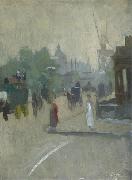 |
August Neven du Mont 
|
|
August Ludwig Mathaeus Neven du Mont (1866-1909) was a German Painter, Master of Foxhounds for East Sussex and aristocrat. Very famous and popular during his lifetime he went from very successful to almost unknown after his early death in 1909. Historian Paul Clemen wrote two books about the life and work of the artist as well as one booklet which was never published. Most of Neven du Mont's Paintings were portraits for which he was most known. In July 1909, he died in his Manor House in Bexhill of which he was the last tenant before its destruction. He was also an ancestor of the well known German actor Sky du Mont.
|
|
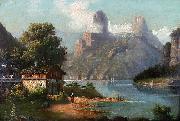 |
August Peters 
|
|
painted Cottage with lake and mountains in 1847
|
|
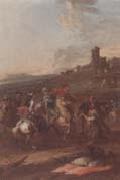 |
August Querfurt 
|
|
Austrian ,Wolfenbuttel 1696-1761
Vienna
|
|
|
|
|
|
|
|
|
| Wholesale China Oil Painting Wholesale Oil Painting China Xiamen Portrait Reproduction on canvas Chinese Oil Painting Wholesale USA Oil Painting |
|
|
|
|